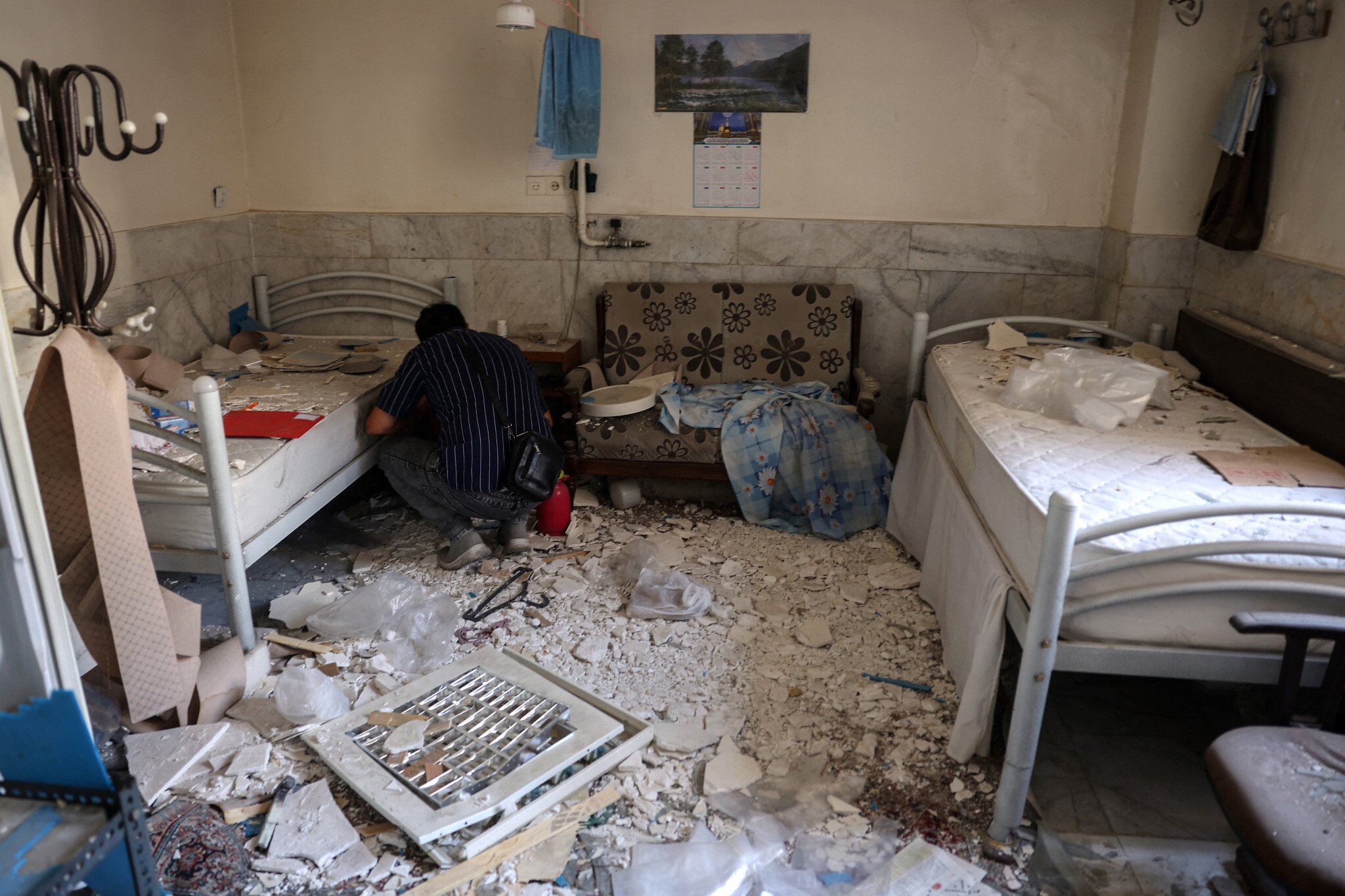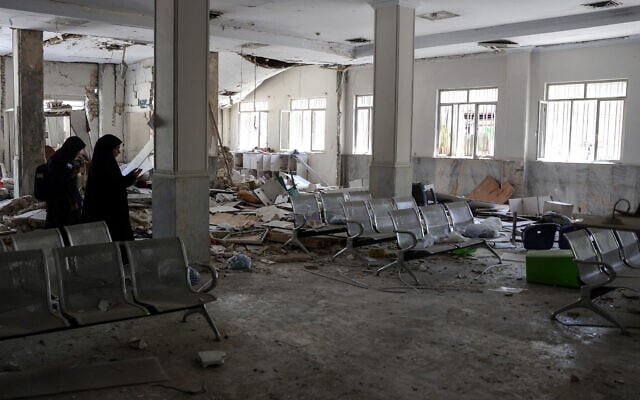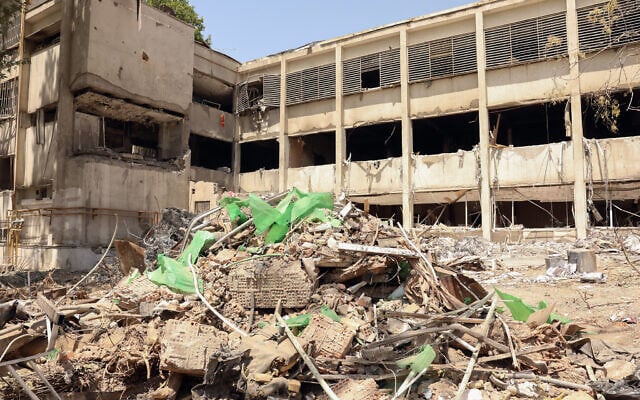



Some two weeks after Israel attacked the notorious Evin Prison in Tehran, Iran invited Western journalists on an unprecedented tour of the site, known for housing political prisoners and foreigners in harrowing conditions.
Footage captured by Sky News showed damage to the prison hospital, with the windows blown out, damaged equipment covered in debris, and exposed wires hanging from the ceiling.
The outlet also showed the exterior of what Iran said was the heavily damaged visitors center, and noted that there were several other damaged buildings in the vicinity of the courtyard, but that filming was not allowed there.
NBC News, which also sent a correspondent to tour the prison, showed a brief clip of one of the damaged administrative buildings.
The strike — which came on the penultimate day of Israel’s 12-day war with Iran last month — sparked concern among family members of those jailed at Evin, who include prominent Iranian dissidents as well as two French nationals considered hostages by their home country.
The attack, which came alongside a strike on Tehran’s “countdown clock” anticipating Israel’s destruction, was widely taken as a signal that Israel was expanding its targets to symbols of the regime, after an initial focus on military and nuclear targets. The next day, a US-brokered ceasefire stopped the fighting.
A Washington Post analysis published Saturday — separate from the journalists’ tours of the site — indicated that the strike involved some four-to-six separate munitions, and targeted four different areas of the complex.
The targets appear to have included an administrative building, a visitation area, a medical center, and a solitary confinement ward.
According to the analysis — based on online death notices, prison records, and interviews — at least 43 prison staffers were killed in the strike, including several high-ranking officials, as well as two conscripted soldiers; at least four civilians who did not work at the prison were killed, two of them children.
Among the dead were two prisoners, according to the Washington-based Human Rights Activists in Iran group.
Iran said at least 71 people total were killed in the attack, though that figure has not been independently verified. Iran also said that prisoners were killed in the strike, but has not said who or how many.
Among the buildings hit was Ward 209, a solitary confinement cell block where prisoners are often blindfolded. One inmate told a friend, who then told the Post, that he saw blindfolded prisoners walking around after the strike, with no guards present.
A man who said he was at the prison gate shortly after the strike told the newspaper that he saw prisoners trying to escape, and that guards shot at their feet.
An analyst who specializes in satellite images taken during wars told the Post that the attack on Evin seemed to have two targets: access points to the prison — possibly to enable a jailbreak, though no prisoners are believed to have escaped as a result of the attack — and prison staff in the complex’s central buildings.
Images indicate that a “lower yield munition was used [rather] than larger-scale airstrikes where the intent is to level the building,” said the analyst, William Goodhind, of the Contested Ground group.
He estimated at least six different bombs were used, echoing another analyst with the same specialty, who told the Post, “There must have been at least four separate munitions.”
The report estimated the attack destroyed or damaged 17 buildings within the sprawling prison complex. It noted that some 60 acres of surrounding vegetation was burned in fires caused by the strike, which may account for some of the damage.
The Israel Defense Forces declined to comment for the Post report, or to answer questions about its targets in the strike.
IDF Spokesman Brig. Gen. Effie Defrin has previously stated that “within the prison compound, intelligence activity was carried out against Israel, including counter-espionage,” and that the strike was carried out “in a pinpoint manner, to avoid harm to those uninvolved.”
Recent reports have also shed light on where prisoners have been transferred after the strike, with some men moved to the Greater Tehran Penitentiary and other men moved to the Ghezel Hesar Prison in Karaj. Women have reportedly been moved to Qarchak Prison.
Transferred prisoners have dealt with overcrowding, shortages of basic necessities like toilets and showers, and severe restrictions on communicating with family, according to relatives.
At the Greater Tehran Penitentiary, “They locked everyone up in a large hall that can hold a maximum of 30 or 40 people, but now they are keeping more than 120 people there,” a family member of a prisoner transferred there told the Post.
Prisoners’ relatives told Human Rights Activists in Iran that prisoners in Greater Tehran Prison and at Qarchak have been denied medical care. At Qarchak, women are held “in security conditions without sanitary support,” the group said.
Israel began an air campaign against Iran’s nuclear and military infrastructure on June 13.
Iran responded to the Israeli attacks with near-daily barrages of missiles at cities, killing 28 people and wounding thousands, according to health officials and hospitals. Some of the missiles hit apartment buildings, a university, and a hospital, causing heavy damage.
Israel said its sweeping assault on Iran’s top military leaders, nuclear scientists, uranium enrichment sites, and ballistic missile program was necessary to prevent the Islamic Republic from realizing its declared plan to destroy the Jewish state. Over the course of the campaign, the list of targets widened, encompassing state television and the Iranian domestic security forces.
After the US also bombed key Iranian nuclear sites, Washington brokered a ceasefire between Israel and Iran.


